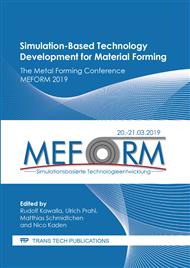[1]
H. P. Hougardy, Hans Paul. Umwandlung und Gefüge unlegierter Stähle. Düsseldorf: Stahleisen GmbH, 2003. 3-514-00423-4.
Google Scholar
[2]
Simonyan, Karen, and Andrew Zisserman. Very deep convolutional networks for large-scale image recognition., arXiv preprint arXiv:1409.1556 (2014).
Google Scholar
[3]
Szegedy, Christian, et al. Going deeper with convolutions., Proceedings of the IEEE conference on computer vision and pattern recognition. (2015).
Google Scholar
[4]
He, Kaiming, et al. Deep residual learning for image recognition., Proceedings of the IEEE conference on computer vision and pattern recognition. (2016).
Google Scholar
[5]
Long, Jonathan, Evan Shelhamer, and Trevor Darrell. Fully convolutional networks for semantic segmentation., Proceedings of the IEEE conference on computer vision and pattern recognition. (2015).
DOI: 10.1109/cvpr.2015.7298965
Google Scholar
[6]
J. Masci, U. Meier, D. Ciresan, J. Schmidhuber and G. Fricout, Steel defect classification with Max-Pooling Convolutional Neural Networks,, The 2012 International Joint Conference on Neural Networks (IJCNN), Brisbane, QLD, 2012, pp.1-6.
DOI: 10.1109/IJCNN.2012.6252468
Google Scholar
[7]
Brian L. DeCost, Toby Francis, Elizabeth A. Holm, Exploring the microstructure manifold: Image texture representations applied to ultrahigh carbon steel microstructures. Acta Materialia, 133, (2017), 30-40.
DOI: 10.1016/j.actamat.2017.05.014
Google Scholar
[8]
Azimi, Seyedmajid, et al (2018). Advanced Steel Microstructural Classification by Deep Learning Methods. Scientific Reports. 8. 10.1038/s41598-018-20037-5.
Google Scholar
[9]
I. Goodfellow, et al. Deep learning. Vol. 1. MIT press, Cambridge, (2016).
Google Scholar
[10]
Rumelhart, David E., Geoffrey E. Hinton, and Ronald J. Williams. Learning representations by back-propagating errors., nature 323.6088 (1986): 533.
DOI: 10.1038/323533a0
Google Scholar
[11]
Bottou, Léon. Large-scale machine learning with stochastic gradient descent." Proceedings of COMPSTAT,2010. Physica-Verlag HD, 2010. 177-186.
DOI: 10.1007/978-3-7908-2604-3_16
Google Scholar
[12]
Bengio, Yoshua, Patrice Simard, and Paolo Frasconi. Learning long-term dependencies with gradient descent is difficult., IEEE transactions on neural networks 5.2 (1994): 157-166.
DOI: 10.1109/72.279181
Google Scholar
[13]
Fukushima, Kunihiko, and Sei Miyake. Neocognitron: A self-organizing neural network model for a mechanism of visual pattern recognition., Competition and cooperation in neural nets. Springer, Berlin, Heidelberg, 1982. 267-285.
DOI: 10.1007/978-3-642-46466-9_18
Google Scholar
[14]
Hubel, David H., and Torsten N. Wiesel. Receptive fields and functional architecture of monkey striate cortex., The Journal of physiology 195.1 (1968): 215-243.
DOI: 10.1113/jphysiol.1968.sp008455
Google Scholar
[15]
Albelwi, S.; Mahmood, A. A Framework for Designing the Architectures of Deep Convolutional Neural Networks. Entropy 2017, 19, 242.
DOI: 10.3390/e19060242
Google Scholar
[16]
LeCun, Yann, et al. Gradient-based learning applied to document recognition., Proceedings of the IEEE 86.11 (1998): 2278-2324.
DOI: 10.1109/5.726791
Google Scholar
[17]
Krizhevsky, Alex, Ilya Sutskever, and Geoffrey E. Hinton. ImageNet classification with deep convolutional neural networks., Advances in neural information processing systems. (2012).
DOI: 10.1145/3065386
Google Scholar
[18]
Russakovsky, Olga, et al. Imagenet large scale visual recognition challenge., International Journal of Computer Vision 115.3 (2015): 211-252.
Google Scholar
[19]
Borovykh, Anastasia, Sander Bohte, and Cornelis W. Oosterlee. Conditional time series forecasting with convolutional neural networks., arXiv preprint arXiv:1703.04691 (2017).
DOI: 10.21314/jcf.2019.358
Google Scholar
[20]
Mulewicz, Bartłomiej, et al. Failures prediction based on performance monitoring of a gas turbine: a binary classification approach., Schedae Informaticae 26.9 (2017): 21.
DOI: 10.4467/20838476si.17.002.7246
Google Scholar
[21]
Nesterov, Yurii. Introductory lectures on convex optimization: A basic course. Vol. 87. Springer Science & Business Media, (2013).
Google Scholar
[22]
Qian, Ning. On the momentum term in gradient descent learning algorithms., Neural networks 12.1 (1999): 145-151.
DOI: 10.1016/s0893-6080(98)00116-6
Google Scholar
[23]
Goodfellow, Ian J., et al. Maxout networks., arXiv preprint arXiv:1302.4389 (2013).
Google Scholar
[24]
Ioffe, Sergey, and Christian Szegedy. Batch normalization: Accelerating deep network training by reducing internal covariate shift., arXiv preprint arXiv:1502.03167 (2015).
Google Scholar
[25]
Pan, Sinno Jialin, and Qiang Yang. A survey on transfer learning., IEEE Transactions on knowledge and data engineering 22.10 (2010): 1345-1359.
Google Scholar
[26]
G. Korpała, PhD thesis, Gefügeausbildung und mechanische Eigenschaften von unlegiertem bainitischem Warmband mit Restaustenit, (2017).
Google Scholar
[27]
Everingham, Mark, et al. The pascal visual object classes (voc) challenge., International journal of computer vision 88.2 (2010): 303-338.
DOI: 10.1007/s11263-009-0275-4
Google Scholar


